This article needs additional citations for verification .(January 2014) |


A plank house is a type of house constructed by indigenous peoples of the Pacific Northwest, typically using cedar planks.
This article needs additional citations for verification .(January 2014) |


A plank house is a type of house constructed by indigenous peoples of the Pacific Northwest, typically using cedar planks.
The oldest plank house village found is located in Kitselas Canyon at the Paul Mason Site in western British Columbia, Canada. This village is estimated to be 3,000 years old. At the Maurer site in British Columbia the remains of a rectangular building have been excavated, providing artifacts which date the site to between 1920 and 2830 BCE. [1]
Due to the nature of this building material, the anthropological documentation for these people is not widespread. The manner of wood harvest and continued use of that harvest was purposeful and sustainable. Native people of the Pacific Northwest maintained a distinct respect for red cedar and the value it had held for many generations. [2]
Cedar logs compose the primary support system of the plank houses of the Pacific Northwest Indians and are clad with thick cedar planks harvested from living trees. Cedar trees have a straight grain with very few knots and have good weather resistance. The straight grain enables the separation of planks of wood from the tree. Craftspeople would insert a wedge to create a section of wood through the tree's height and remove it with an adze at both ends. This harvest method was sustainable and enabled the people to use the wood and to have a supply of planks to rebuild in another location. The people's patience is evident in the practice of leaving the wedge in place to continue the pressure that would enable another wedge placement further up, creating longer planks.
Canadian anthropologist Wilson Duff quotes Simon Fraser, who (upon observation of the Coast Salish homes on the banks of the now-named Fraser River) wrote in his 1800 journal; "as an excellent house 46 × 32 and constructed like American frame houses; the planks are three to 4 inches thick, each plank overlapping the adjoining one a couple of inches; the post, which is very strong and crudely carved, received across beams; the walls are 11 feet high and covered with a slanting roof. On the opposite side of the river, there is a considerable village with houses similar to the one on the side." Kenneth Ames, a contributor to Life in the Big House; Household Labor and Dwelling Size on the Northwest Coast, calculates the volume of wood in this house to exceed half a million board feet (1,200 m3). A multi-family house found in Nanaimo, on the eastern coast of Vancouver Island, Canada, is documented as being made of split cedar planks that were "held in place by withes (cedar rope) that come from the long lower branches of Cedar trees that grow in open spaces." (Fraser)

The cedar ropes that secured the planks to the uprights and beams allowed the people to deconstruct their homes and bring their planks with them to the next location. These planks were neither small nor easily obtained, but they were valuable assets and, as such, they were transported with household goods during the seasonal migrations. The house frames were left intact until the next season when the people returned and reattached their traveling planks and reconstructed their homes.
There were two distinct roof types found in this region. Both types are placed on a rectangular house that has a hearth or fire pit. One type consists of gabled, paired ridgepoles, vertical walls, and roof planks with an interior pit that was reached via steps. James Cook described the shed roof structures on Vancouver Island and around Puget Sound. His description is that of a cruder type of building that may have been in the adaptive stages of the house type possibly brought to the coast by the Salish people, who modified it as needed with the location change. These shed-roof houses are the largest constructed anywhere in this region.
The articles that have been written by anthropologists describe the shed roofs as being shed types that are not consistent in the description of the roof pitch. One informant will state that the roof was slanted to the back of the house, and another will say it was pitched to the front or the side of the house. The roof pitch was adjusted according to the direction from which the rain came down. Regionally, the rain comes from the south.

In 1778, during his third mapping voyage, James Cook described the homes he saw at Nootka Sound as not having a door. He described irregular openings through which the Indians passed in and out. The "Old Man House" had a maze "consisting of a series of parallel walls partly uncovering each other, around which the visitor had to pass." The maze ended in a dark area that housed the fire pit. One explanation for this configuration was as a defense against intruders. Alternately, because the lack of doors and the cedar mat room dividers did little to keep the wind and rain out, the mats may have served as windbreaks.
Anthropologist Ronald Leroy Olson, whose subjects were the Quinault, Tlingit and Kwakiutl tribes, defines the coasts of the Pacific Northwest as the place for rectangular plank houses, from the coastal region of British Columbia to the mouth of the Copper River in Alaska, with one exception: the Athabascan Tseutsaut of the head of Portland Canal, who used temporary brush and bark lodges. The Alaskan people are more likely to use spruce wood, which has characteristics similar to cedar, due to the availability of that resource. Cedar was the material of choice for the coastal people of southwestern Canada, and Washington, Oregon, and Northern California.

Totem poles are monumental carvings found in western Canada and the northwestern United States. They are a type of Northwest Coast art, consisting of poles, posts or pillars, carved with symbols or figures. They are usually made from large trees, mostly western red cedar, by First Nations and Indigenous peoples of the Pacific Northwest Coast including northern Northwest Coast Haida, Tlingit, and Tsimshian communities in Southeast Alaska and British Columbia, Kwakwaka'wakw and Nuu-chah-nulth communities in southern British Columbia, and the Coast Salish communities in Washington and British Columbia.

The Kwakwa̱ka̱ʼwakw, also known as the Kwakiutl, are one of the indigenous peoples of the Pacific Northwest Coast. Their current population, according to a 2016 census, is 3,665. Most live in their traditional territory on northern Vancouver Island, nearby smaller islands including the Discovery Islands, and the adjacent British Columbia mainland. Some also live outside their homelands in urban areas such as Victoria and Vancouver. They are politically organized into 13 band governments.

The Chehalis people or Tsihalis are a native people of western Washington state in the United States. They should not be confused with the similarly named Chehalis First Nation of the Sts'Ailes people along the Harrison River in the Fraser Valley area of British Columbia.
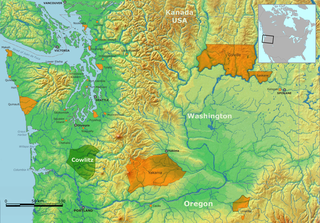
The term Cowlitz people covers two culturally and linguistically distinct indigenous peoples of the Pacific Northwest; the Lower Cowlitz or Cowlitz proper, and the Upper Cowlitz / Cowlitz Klickitat or Taitnapam. Lower Cowlitz refers to a southwestern Coast Salish people, which today are enrolled in the federally recognized tribes: Cowlitz Indian Tribe, Quinault Indian Nation, and Confederated Tribes of the Chehalis Reservation. The Upper Cowlitz or Taitnapam, is a Northwest Sahaptin speaking people, part of the Confederated Tribes and Bands of the Yakama Nation.

The Stillaguamish people are a Southern Coast Salish people Indigenous to the Stillaguamish River valley in northwestern Washington State in the United States, near the city of Arlington, Washington. The Stillaguamish speak Northern Lushootseed, a Coast Salish language. Although usage of the language has declined, there are ongoing revitalization efforts by the Stillaguamish Tribe.

The Quinault are a group of Native American peoples from western Washington in the United States. They are a Southwestern Coast Salish people and are enrolled in the federally recognized Quinault Tribe of the Quinault Reservation.

Thuja plicata is a large evergreen coniferous tree in the family Cupressaceae, native to the Pacific Northwest of North America. Its common name is western redcedar in the U.S. or western red cedar in the UK, and it is also called pacific red cedar, giant arborvitae, western arborvitae, just cedar, giant cedar, or shinglewood. It is not a true cedar of the genus Cedrus. T. plicata is the largest species in the genus Thuja, growing up to 70 metres (230 ft) tall and 7 m (23 ft) in diameter. It mostly grows in areas that experience a mild climate with plentiful rainfall, although it is sometimes present in drier areas on sites where water is available year-round, such as wet valley bottoms and mountain streamsides. The species is shade-tolerant and able to establish in forest understories and is thus considered a climax species. It is a very long-lived tree, with some specimens reaching ages of well over 1,000 years.
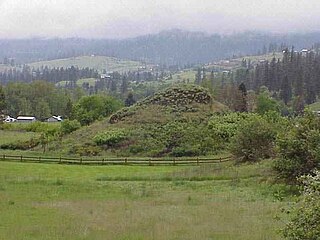
Indigenous peoples of the Northwest Plateau, also referred to by the phrase Indigenous peoples of the Plateau, and historically called the Plateau Indians are Indigenous peoples of the Interior of British Columbia, Canada, and the non-coastal regions of the Northwestern United States.

Longhouses were a style of residential dwelling built by Native American and First Nations peoples in various parts of North America. Sometimes separate longhouses were built for community meetings.
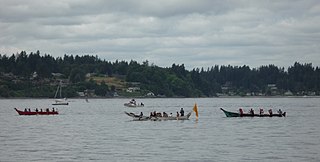
The Intertribal Canoe Journey is a celebrated event of the Indigenous peoples of the Pacific Northwest Coast. Organizers call it the Canoe Journey or Intertribal Canoe Journey, and colloqually Tribal Journeys. It is also referred to by its destination, i.e. Paddle to Muckleshoot.
The Squamish people are an indigenous people of the Pacific Northwest Coast. Archaeological evidence shows they have lived in the area for more than a thousand years. In 2012, there was population of 3,893 band members registered with the Squamish Nation. Their language is the Squamish language or Sḵwx̱wú7mesh snichim, considered a part of the Coast Salish languages, and is categorized as nearly extinct with just 10 fluent speakers as of 2010. The traditional territory is in the area now in southwestern British Columbia, Canada, and covers Point Grey as the southern border. From here, it continues northward to Roberts Creek on the Sunshine Coast, up the Howe Sound. The northern part includes the Squamish, Cheakamus, Elaho and Mamquam rivers. Up the Cheakamus River it includes land past Whistler, British Columbia. The southern and eastern part of their territory includes Indian Arm, along Burrard Inlet, through False Creek then English Bay and Point Grey. Today the Squamish people live mostly in seven communities, located in West Vancouver, North Vancouver, and within and nearby to the District of Squamish.
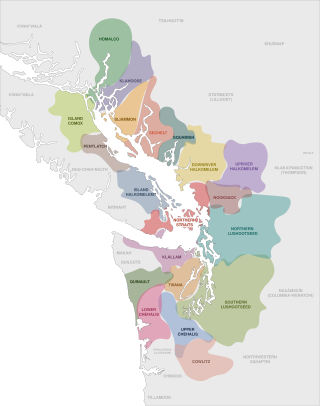
The Coast Salish are a group of ethnically and linguistically related Indigenous peoples of the Pacific Northwest Coast, living in the Canadian province of British Columbia and the U.S. states of Washington and Oregon. They speak one of the Coast Salish languages. The Nuxalk nation are usually included in the group, although their language is more closely related to Interior Salish languages.
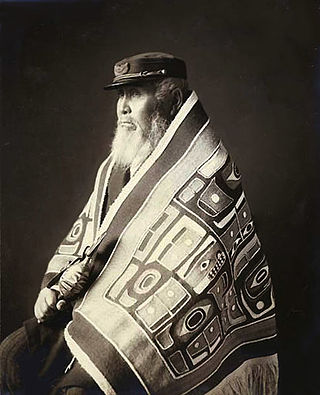
The Indigenous peoples of the Pacific Northwest Coast are composed of many nations and tribal affiliations, each with distinctive cultural and political identities. They share certain beliefs, traditions and practices, such as the centrality of salmon as a resource and spiritual symbol, and many cultivation and subsistence practices. The term Northwest Coast or North West Coast is used in anthropology to refer to the groups of Indigenous people residing along the coast of what is now called British Columbia, Washington State, parts of Alaska, Oregon, and Northern California. The term Pacific Northwest is largely used in the American context.

The Lekwungen or Lekungen nation are an Indigenous North American Coast Salish people who reside on southeastern Vancouver Island, British Columbia in the Greater Victoria area. Their government is the Songhees First Nation, a member of the Te'mexw Treaty Association and the Naut'sa Mawt Tribal Council. Their traditional language is Lekwungen, a dialect of the North Straits Salish language.

Coast Salish art is an art unique to the Pacific Northwest Coast among the Coast Salish peoples. Coast Salish are peoples from the Pacific Northwest Coast made up of many different languages and cultural characteristics. Coast Salish territory covers the coast of British Columbia and Washington state. Within traditional Coast Salish art there are two major forms; the flat design and carving, and basketry and weaving. In historical times these were delineated among male and female roles in the community with men made "figurative pieces, such as sculptures and paintings that depicts crest, shamanic beings, and spirits, whereas women produced baskets and textiles, most often decorated with abstract designs."
Squamish culture is the customs, arts, music, lifestyle, food, painting and sculpture, moral systems and social institutions of the Squamish indigenous people, located in the southwestern part of British Columbia, Canada. They refer to themselves as Sḵwx̱wú7mesh. They are a part of the Coast Salish cultural group. Their culture and social life is based on the abundant natural resource of the Pacific Northwest coast, rich in cedar trees, salmon, and other resources. They have complex kinship ties that connect their social life and cultural events to different families and neighboring nations.
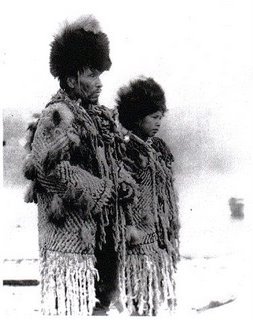
Salish are skilled weavers and knitters of the Pacific Northwest. They are most noted for their beautiful twill blankets many of which are very old. The adoption of new fabrics, dyes, and weaving techniques allow us to study a wide variety of Salish weavings today.

The Salish peoples are indigenous peoples of the American and Canadian Pacific Northwest, identified by their use of the Salish languages which diversified out of Proto-Salish between 3,000 and 6,000 years ago.

The History of the Coast Salish, a group of Native American ethnicities on the Pacific coast of North America bound by a common culture, kinship, and languages, dates back several millennia. Their artifacts show great uniformity early on, with a discernible continuity that in some places stretches back more than seven millennia.

Yellow cedar is a culturally, economically and environmentally significant species to the Pacific Northwest and was used extensively by Indigenous Peoples throughout the region.
Plank house. (2023, November 6). In Wikipedia. https://en.wikipedia.org/wiki/Plank_house